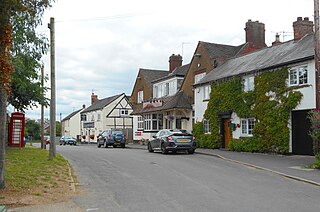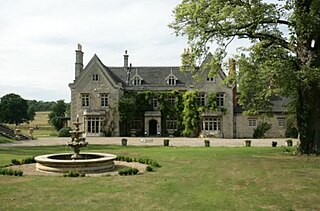
Fountains Abbey is one of the largest and best preserved ruined Cistercian monasteries in England. It is located approximately 3 miles (5 km) south-west of Ripon in North Yorkshire, near to the village of Aldfield. Founded in 1132, the abbey operated for 407 years, becoming one of the wealthiest monasteries in England until its dissolution, by order of Henry VIII, in 1539.

Rugby is a market town in eastern Warwickshire, England, close to the River Avon. At the 2021 census its population was 78,125, making it the second-largest town in Warwickshire. It is the main settlement within the larger Borough of Rugby, which had a population of 114,400 in 2021.

The Borough of Rugby is a local government district with borough status in eastern Warwickshire, England. The borough comprises the town of Rugby where the council has its headquarters, and the rural areas surrounding the town. The borough has a population of 114,400 (2021). Of which, 78,125 live in Rugby itself and the remainder living in the surrounding areas. Aside from Rugby itself, more notable settlements include Binley Woods, Brinklow, Clifton-upon-Dunsmore, Dunchurch, Long Lawford, Monks Kirby, Ryton-on-Dunsmore, Stretton-on-Dunsmore and Wolston, and the new large development of Houlton.

Dunchurch is a large village and civil parish on the south-western outskirts of Rugby in Warwickshire, England, approximately 2.5 miles (4.0 km) southwest of central Rugby. The civil parish, which also includes the nearby hamlet of Toft, had a population of 4,123 at the 2021 Census, a significant increase from 2,938 at the 2011 Census.

Newbold-on-Avon is a suburb of Rugby in Warwickshire, England, located around 1½ miles north-west of the town centre, it is adjacent to the River Avon from which the suffix is derived. Newbold was historically a village in its own right, but was incorporated into Rugby in 1932. The name is derived from the Saxon Niowebold.

Long Lawford is a village and civil parish in the Rugby borough of Warwickshire, England, located just west of Rugby, around 1.75 miles (2.82 km) west of Rugby town centre. In the 2021 census, the population of the parish was 4,545, a significant increase from 3,180 at the 2011 census, and 2,863 in 2001.

Rugby and Kenilworth was a county constituency in Warwickshire, England. It returned one Member of Parliament to the House of Commons of the Parliament of the United Kingdom. It existed from 1983 to 2010.

Bordesley Abbey was a 12th-century Cistercian abbey near the town of Redditch, in Worcestershire, England.

Pipewell is a village in the civil parish of Rushton, in the North Northamptonshire district, in the ceremonial county of Northamptonshire, England. It is a mile away from Corby. With 63 inhabitants, it is one of the smallest villages in Northamptonshire. A Community Governance Review concluded in February 2015 resulted in the ward of Pipewell being moved from civil parish of Wilbarston to Rushton.

Rugby is a constituency represented in the House of Commons of the UK Parliament since its 2010 recreation by Mark Pawsey, a Conservative.

This is about the history of the town of Rugby, Warwickshire, England.
Cawston is a civil parish and suburban village close to the south west of Rugby, on the A4071. The population of the civil parish at the 2011 census was 3,234. For hundreds of years the village was basically a hamlet and the two settlements remained separate despite Rugby's continued growth. However, in 2003-04 a new housing development, Cawston Grange, was completed all but connecting the two settlements. Cawston Grange Primary School was built at the same time to educate children in the area aged 4–11 and there is a nursery for pre-school children, as well as a public house and shops.
Little Lawford is a hamlet and civil parish around 0.6 miles (0.97 km) to the north of the much larger village of Long Lawford and west of Rugby in Warwickshire, England. Consisting of 5 dwellings plus numerous other buildings that are used for commercial or farming business, in 2001 the parish had a population of 12 people. In the 2011 Census the population details were recorded under Long Lawford.

Bilton Hall is a 17th-century mansion house in the Bilton area of Rugby, Warwickshire which has been converted into residential apartments. It is a Grade I listed building. It was once the home of the poet and essayist Joseph Addison and of the sporting writer Charles James Apperley.
The Rugby Western Relief Road (RWRR) is a 3.7-mile (6 km) single carriageway bypass road which is on the outskirts of Rugby, Warwickshire, England. The £36.6 million scheme includes a £17.08 million contribution from the Department for Transport and was expected to be completed by the end of 2009 but the date was put back by a year, eventually opening in September 2010. There was also much speculation that the project went well over budget.

Pipewell Hall in Northamptonshire, England, is a building of historical significance and is Grade II listed on the English Heritage Register. It was built near the ruins of a Cistercian abbey in 1675. At this time it was owned by the Barons of Powis. The house was constructed from the stones of the abbey. The Hall was the home of many notable people over the next three centuries and is now a wedding venue.














